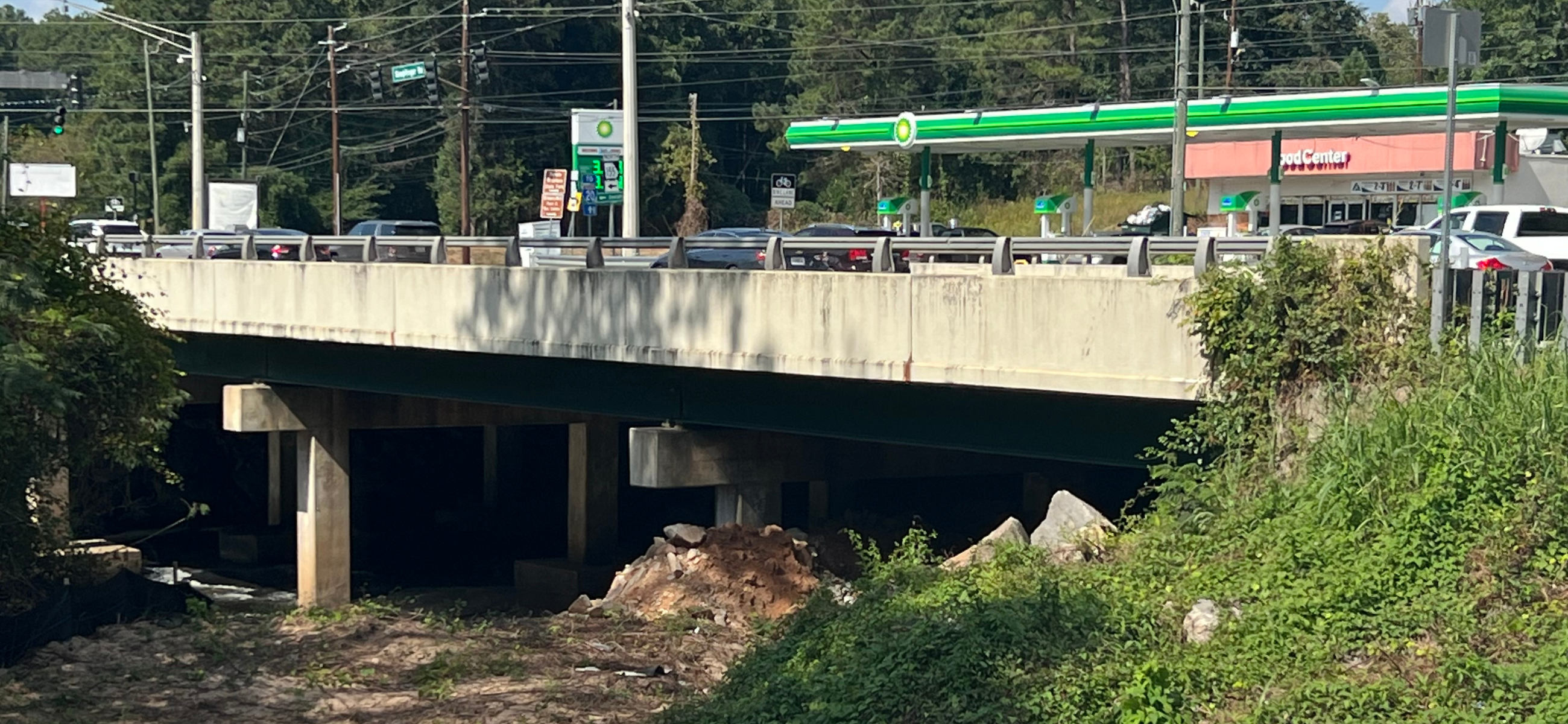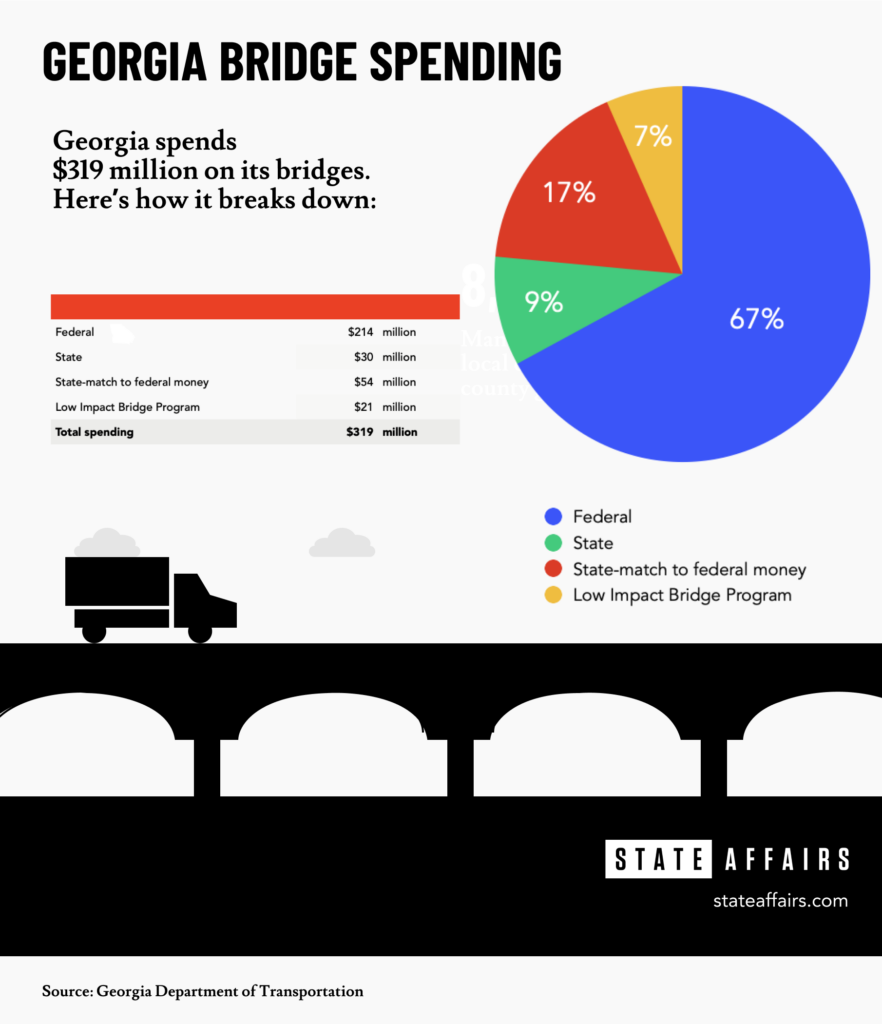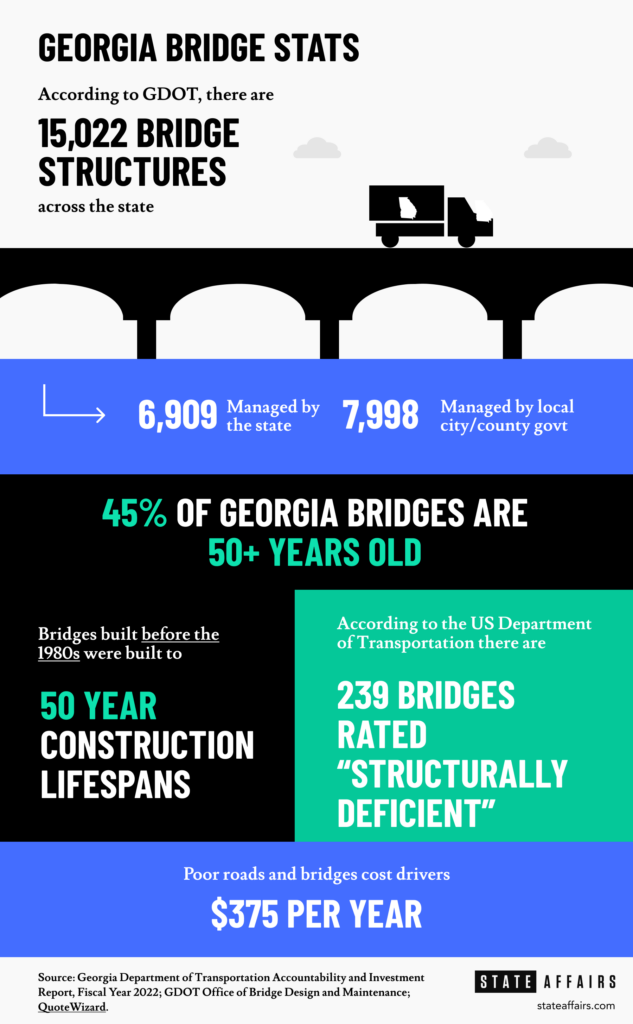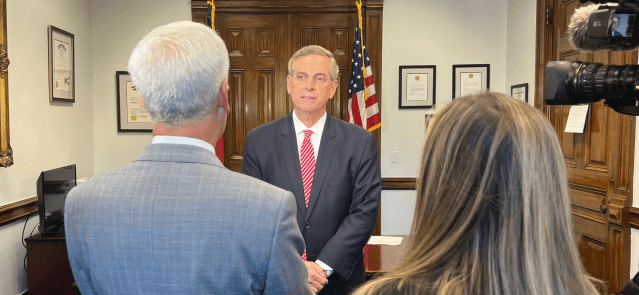Stay ahead of the curve as a political insider with deep policy analysis, daily briefings and policy-shaping tools.
Request a DemoHow Georgia’s 8-year-old infrastructure initiative is paying off

The bridge on Snapfinger Road in DeKalb county crosses over Snapfinger Creek. A national report said it is one of Georgia’s most traveled bridges, and one of its most structurally deficient bridges. It was built in 1954. (Credit: Tammy Joyner)
The Gist
Six years ago, Georgia had more than 700 bridges in poor condition. Today, the state’s list of structurally deficient bridges has fallen to 239.
In fact, fewer than 2% of Georgia’s 15,022 bridges are classified as structurally deficient now — a feat that hasn’t gone unnoticed by those who track the condition of the nation’s 617,000 bridges. The number of bridges in poor condition dropped nearly 66% in just the last four years.
“That is very impressive to go from 441 [structurally deficient bridges] down to 239,” Alison Black, chief economist of the American Road & Transportation Builders Association, told State Affairs. Black has tracked and written reports about U.S. bridges for a decade.
What’s Happening
Georgia ranked 48th nationally in percent of structurally bad bridges and last among states where the percentage of the deck area — the surface on which vehicles drive — is structurally deficient, according to the association’s report released in August.
“This is a list [where] you want to be on the bottom,” Black said. “So that really indicates just looking at the data, that this has been … maybe a priority might not be the right word. Again, I don’t want to speak for the [Georgia] DOT [Department of Transportation] but they have definitely put resources towards addressing this issue in the state.”
So what’s behind Georgia’s performance?
In July 2015, state lawmakers launched an innovative transportation funding initiative. Then-Gov. Nathan Deal signed into law the Transportation Funding Act to provide money to repair, improve and expand Georgia’s infrastructure, including bridges. The state has allocated “another $1 billion a year” for the nation’s 10th largest infrastructure network through proceeds raised from state gas taxes.
“Gov. Deal, and our current administration as well, was firm that bridges are important, whether they’re local or state-owned, and we are going to invest in bridges,” Meg Pirkle, chief engineer at the Georgia Department of Transportation, told State Affairs. “So starting in 2016, we increased our spend on bridges, I would say times three or four every year and we are maintaining that.”
While the 239 bridges are in poor condition, most are still in use. For instance, nearly 28,000 motorists cross DeKalb County’s Snapfinger Road bridge on any given day.

Lorenzo Parks uses the bridge that crosses Snapfinger Creek about twice a month, yet he had no idea that it’s among the top 10 most traveled and structurally deficient bridges in Georgia.
“People need to be better informed about the situation, maybe that way we can share our concerns,” the 70-year-old Decatur resident said recently while gassing up his black Silverado Chevy pickup at a gas station across from the bridge.
“Poor condition doesn’t mean they [the bridges] are dangerous. It just means that there’s things that need to be fixed,”Pirkle said.
Why It Matters
All bridges — state and local — are inspected every other year, she said.
“If they need attention, we provide the correct attention. We’re going to close the bridge if it needs to be closed. If it needs maintenance, we’re going to do the maintenance and if it needs to be replaced, we put it on the list for replacement,” Pirkle said. “So it’s not like I worry at night that people are driving over a bridge that has a poor rating because I know that it’s safe.”
Currently, there are 49 bridges in Georgia that are closed, only one is owned by the state.The rest are owned by local governments.
“For the most part, a lot of our bridges are in the good and fair state,” State Bridge Engineer Donn Digamon told State Affairs.

In addition to state money, Georgia gets a total of $225 million in federal bridge formula money through 2025. The money comes from the $1 trillion Infrastructure Investment and Jobs Act Pres. Biden signed into law in 2021 to invest in roads, bridges, railroads and broadband internet.
While states have access to $10.6 billion in federal infrastructure money, only 30% of that money has been committed to 2,060 bridge projects nationwide as of June. Georgia, however, already has committed all of its available $90 million federal infrastructure money to 54 projects.
The Georgia Department of Transportation still has work — and challenges — ahead.
Georgia has 13,740 bridges in need of some sort of repair, up slightly from the 13,676 bridges that needed work in 2019, according to the American Road & Transportation Builders Association’s report which is based on findings from the Federal Highway Administration’s National Bridge Inventory.
Complicating matters: Bridges in some parts of the state are now handling trucks carrying heavier loads.
State lawmakers passed a bill in March allowing trucks in the agriculture and forestry industries to carry heavier loads. Gov. Kemp signed HB 189 on May 5. The new law allows trucks in those industries to haul up to 88,000 pounds, up from 84,000 pounds. The trucks can travel up to 150 miles from the farm or processing plant where the load originated. The law is good through June 2025, giving lawmakers time to reach a permanent compromise.
State officials told lawmakers earlier this year that more than 700 bridges in Georgia can’t handle the increased weight limits. Those bridges include 306 state-owned bridges and 427 local bridges. The state has since posted weight limits on 733 bridges, Digamon said.
“We do know that these heavier weights, or what we call axle weights, the individual axles just over time — when you give anything time — will accelerate the pace of deterioration,” he added.
The heavier weight is most likely to be a problem in rural areas. More than half of all truck trips in Georgia pass through rural areas at some point during their journey, according to the Georgia Chamber of Commerce Third Quarter report released earlier this month.

Weight-posted bridges require detours that are nearly 35% longer, on average, in rural areas than posted bridges in metro Atlanta, the report noted. Declining bridge conditions pose a serious mobility issue for motorists and railways. Some 13% of bridges in rural areas are posted with weight restrictions compared to 7% in metro atlanta
“This is causing connectivity issues in rural Georgia,” the report said.
Nationally, 1 in 3 bridges need to be replaced or repaired, even as the country’s share of bridges in poor condition continues to slowly improve, the report said. At that current rate, it would take 75 years to fix all of the bridges that need work, the report noted.
“We really increased our spending on bridges because Georgia is a growing state and keeping our bridges in good health is so important for not just the interstates but for agriculture and growth in and around the ports and everything,” Pirkle said. “I mean, it can really restrict travel if you have restrictions on bridges.”
What’s Next?
Earlier this year, national auto insurance comparison company QuoteWizard ranked Georgia as having the best infrastructure in the nation. As a result, Georgians have the fifth-cheapest driving costs in the country, paying about $375 a year.
“The goal is always to be providing the biggest bang for the buck for the taxpayer because this is all taxpayer money.” Digamon said. “So, I think we’re doing a fairly good job at this point for the taxpayer of Georgia.”
GEORGIA BRIDGES: BY THE NUMBERS
State and local bridges inspected annually: 8,824
State-owned bridges repaired annually: 46
Average age of a bridge in Georgia: 46.3
State-owned bridges repaired so far this year: 142
Bridges in good condition: 77.7%
Bridges in fair condition: 21.3%
Bridges in poor condition: 239 or 1%
Bridges currently closed: 49 – 1 state-owned; the rest are local government-owned
Bridge replacement and construction projects: 154
Total cost of those projects: $821 million
Source: Georgia Department of Transportation Accountability and Investment Report, Fiscal Year 2022 and National Bridge Inventory, Georgia data, 2023.
Have questions, comments or tips? Contact Tammy Joyner on X @lvjoyner or at [email protected].
X @StateAffairsGA
Instagram@StateAffairsGA
Facebook @StateAffairsGA
LinkedIn @StateAffairs
Newly minted Senate Minority Leader Harold Jones II: ‘I’m not the typical back-slapping politician’
Nearly 10 years into legislative life, Sen. Harold Jones II wouldn’t change anything about the experience. “I love every minute of it. Even when I hate it, I love it,” the 55-year-old Augusta Democrat told State Affairs. Come January, Jones will add another role to his legislative duties: Senate minority leader, a job held for …
Gov. Kemp calls on state agencies to be fiscally restrained amid record $16.5B surplus
The Gist Gov. Brian Kemp asked the state’s 51 government agencies for continued fiscal restraint when drafting their amended fiscal year 2025 and 2026 budgets. Most agencies adhered to his request even as the state’s general fund surplus hit a record $16.5 billion last month. Forty-five agencies, excluding state courts, followed the governor’s instructions to …
Georgia defies bomb threats as election chief declares a “free, fair and fast” vote amid record turnout
ATLANTA – Despite dealing with over 60 bomb threats, Georgia’s election chief said Tuesday the state’s general election went smoothly. Georgia had a record turnout with nearly 5.3 million people voting, Secretary of State Brad Raffensperger told reporters. Election officials in the state’s 159 counties have until 5 p.m. to certify votes. “We had a …
In the (state)house: Meet the newest members of the Georgia legislature
When lawmakers reconvene at the state Capitol on Jan. 13, there’ll be a cadre of new faces in the 236-member Georgia General Assembly, one of the nation’s largest state legislatures. All 236 statehouse seats were up for election this year. Most candidates ran unopposed. Incumbents in contested races easily kept their seats, with the exception …




